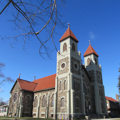Settled by German Catholic families, Lenox and present-day Richmond remained until the 1930s one town named Lenox. Here St. Augustine was established as a mission in 1880, and a wooden church was built in 1888. The growing number of Catholics in the area necessitated a larger church, and in 1913, under the leadership of the Reverend Edward Schrauder, pastor of St. Augustine's from 1905 until his death in 1934, the parish began a twenty-nine-year building campaign. The stone cross-shaped church, with its three-staged twin towers and triple entrance, recalls Dederichs's St. Mary's Catholic Church, erected in 1885 in Detroit ( WN40). The low, pointed-arched windows resemble the northern Italian Gothic mode. Although Dederichs specified that the buttressed walls of St. Augustine Church be constructed of the best-quality cut stone, instead, they were constructed of cobblestones and fieldstones gathered by the parishioners from their fields. The execution of this high-style design in the locally available material resulted in a delightful vernacular work of architecture that sings native Michigan. A cobblestone rectory of the bungalow type and a school were built adjacent to the church in 1926 and 1930, respectively.
You are here
St. Augustine Church
If SAH Archipedia has been useful to you, please consider supporting it.
SAH Archipedia tells the story of the United States through its buildings, landscapes, and cities. This freely available resource empowers the public with authoritative knowledge that deepens their understanding and appreciation of the built environment. But the Society of Architectural Historians, which created SAH Archipedia with University of Virginia Press, needs your support to maintain the high-caliber research, writing, photography, cartography, editing, design, and programming that make SAH Archipedia a trusted online resource available to all who value the history of place, heritage tourism, and learning.





